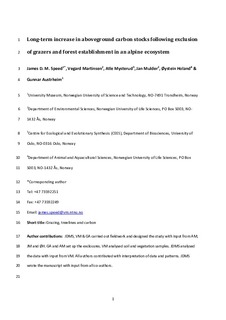Long-Term Increase in Aboveground Carbon Stocks Following Exclusion of Grazers and Forest Establishment in an Alpine Ecosystem
Speed, James David Mervyn; Martinsen, Vegard; Mysterud, Atle; Mulder, Jan; Holand, Øystein; Austrheim, Gunnar
Journal article, Peer reviewed
Accepted version
Permanent lenke
http://hdl.handle.net/11250/2466286Utgivelsesdato
2014Metadata
Vis full innførselSamlinger
- Institutt for naturhistorie [1222]
- Publikasjoner fra CRIStin - NTNU [37763]
Sammendrag
Ecosystem stores of carbon are a key component in the global carbon cycle. Many studies have examined the impact of climate change on ecosystem carbon storage, but few have investigated the impact of land-use change and herbivory. However, land-use change is a major aspect of environmental change, and livestock grazing is the most extensive land use globally. In this study, we combine a grazing exclosure experiment and a natural experiment to test the impact of grazer exclusion on vegetation dynamics and ecosystem carbon stores in the short term (12-year exclosures), and the long term (islands inaccessible to livestock), in a heavily grazed mountain region in Norway. Following long-term absence of sheep, birch forest was present. The grazing-resistant grass Nardus stricta, dominated under long-term grazing, whilst the selected grass Deschampsiaflexuosa and herb species dominated the vegetation layer in the long-term absence of sheep. The established birch forest led to vegetation carbon stocks being higher on the islands (0.56 kg C m−2 on the islands compared to 0.18 kg C m−2 where grazed) and no difference in soil carbon stocks. In the short-term exclusion of sheep, there were minor differences in carbon stocks reflecting the longer term changes. These results show that aboveground carbon stocks are higher in the long-term absence of sheep than in the continual presence of high sheep densities, associated with a vegetation state change between tundra and forest. The reduction of herbivore populations can facilitate forest establishment and increase aboveground carbon stocks, however, the sequestration rate is low.
